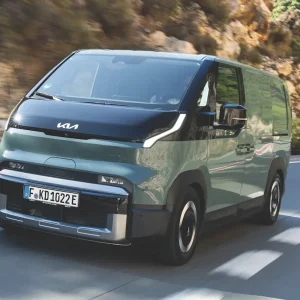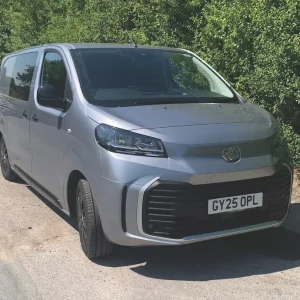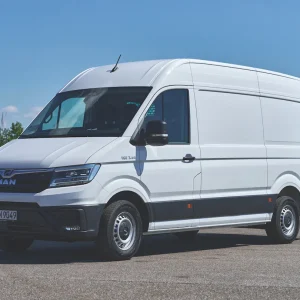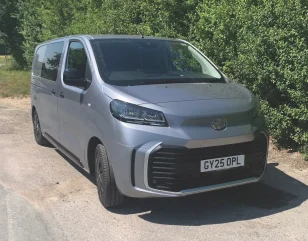
2nd Report
Now that I’ve been living with the Proace Sport Crew van for a couple of months, I’ve had the chance to experience its performance in a wider range of environments and conditions. My overall impressions are favourable – the van has acquitted itself well during both urban and extra-urban assignments.
With a 20mph speed limit now in force across much of London, van drivers need to have their wits about them to keep legal. The Proace’s Road Sign Assist and Intelligent Speed Assist help to keep you on the right side of the law. But if you do stray above the threshold, an audible warning prompts you to slow down.
This can be irritating, so if you want to take your chances, it can be deactivated for each individual journey. Unfortunately, the lowest speed the limiter can be set to is 30mph, but with 20mph becoming the norm in urban and even some rural areas, manufacturers will likely soon adjust this downwards.
I have continued to make full use of the van’s load-carrying capacity in recent weeks with furniture-moving missions between student digs and trips to recycling centres to offload household goods and garden waste. Despite the lack of the load-through hatch in the crew van, I have found the extra space under the bulkhead and rear seat bench useful for stowing longer items such as a full-length mirror and lamp holders. The load bed could do with more protection against scrapes and scratches than just the modest ply boards fitted above the wheel arch housing, however. A protective floor covering would be a useful addition, for example.

During longer journeys beyond the confines of the capital, the Sport’s 175hp engine, the most powerful available in the Proace line-up, comes into its own.
With brisk acceleration from a standing start – Toyota claims a 0–62mph sprint of 8.5 seconds – the Sport is a strong performer on dual carriageways and motorways, where it is more than able to hold its own in the overtaking lanes and well suited to covering long distances economically at speeds of 50mph or above. Wind noise does become intrusive at higher speeds though, making it difficult to hear the radio.
A lane departure alert tugs the wheel back if the driver attempts to change lanes without indicating but I would appreciate a blind spot warning too for added safety on the motorway. While cruise control is part of the package, along with the aforementioned speed limiter, this would be better, and safer, if it was adaptive in order to keep a safe distance between the Proace Sport and the vehicle in front.
While perhaps not as dynamic as the Ford Transit Custom or Volkswagen Transporter, the Proace handles well, with the electro-hydraulic steering imparting reassuring feedback on more challenging roads and the suspension, Macpherson strut-type at the front and wishbones with trailing arms, variable stiffness springs and load-adaptive shock absorbers at the rear, providing stability.
The eight-speed automatic transmission is smooth and composed throughout its range, there is no lurching between cogs, and I have rarely been tempted to override it with the paddle controls on the steering column. A finger switch enables the driver to simply select park, neutral, drive or reverse. The handbrake, on the other hand is an old-school, manual lever.
The Proace Sport’s interior is reasonably comfortable for driver and passengers alike. The high, upright driving position helps to give a good view of the road ahead but the wing mirrors could do with a wide-view angle for better vision behind the vehicle. In my previous report I mentioned that the middle seat rear headrest obscured the driver’s sightline through the rear-view mirror. With some difficulty due to the lack of space between headrest and roof, I have managed to remove the headrest to provide a clearer view.

A 10in multimedia display comes with all Proace grades, along with DAB radio, Bluetooth and a 10in digital instrument cluster. USB ports for charging are also provided, together with wireless smartphone integration. Icon, Icon Premium and Sport versions also provide an embedded navigation system. I prefer to use the navigation through my smartphone for more frequent traffic alerts but have found connectivity is occasionally lost, as is DAB radio reception.
Report card
Handling/Performance: A decent steering response combines with smooth automatic transmission and an engine offering plenty of punch.
9/10
Refinement: Build quality is good but wind noise is intrusive at motorway speeds.
7/10
| Model | Toyota Proace Sport Crew Cab 2.0 Auto |
| Mileage | 1,815 |
| Official combined fuel economy | 39.2mpg |
| Our average consumption | 47.7mpg |
| Price range (ex VAT) | £28,474 – £37,765 |
| Price (ex VAT) | £37,765 |
| Insurance group | 35E |
| Warranty | 3yrs/60,000mls (extendable up to 10 years/100,000mls) |
| Service intervals | 10,000mls |
| Load length | 1,488mm |
| Load width (min/max) | 1,258mm /1,636mm |
| Load bay height | 1,397mm |
| Gross payload | 1,226kg |
| Load volume | 3.2m3 |
| Engine size/power | 1,997cc/177hp |
| CO2 | 205g/km |
1st Report
The Proace is the longest-serving member of Toyota’s van line-up, having replaced the medium-sized Hiace in 2013.
Subsequently, Toyota has expanded its commercial range to become one of the most extensive in the sector but it is the Proace that has played the leading role in steering the brand away from being known only for the Hilux pick-up in LCV circles.
In 2023, Toyota’s vans outsold the Hilux in the UK for the first time. The timing was significant; as the brand’s UK LCV boss Gareth Matthew told What Van?, “Fleets out there are buying fewer pick-ups,” partly because of the law change that means double-cab pick-ups no longer enjoy the favourable tax regime that drove up sales in the UK.
The Proace marked the beginning of Toyota Professional’s product collaboration with what was then PSA Peugeot Citroen and has since expanded into Stellantis. Consequently, customers can buy similar models badged as the Citroen Dispatch, Fiat Professional Scudo, Peugeot Expert and Vauxhall Vivaro.
Toyota updated the Proace in 2024 with a new front end, giving the grille a wide-mouthed appearance. The van is available as a medium (L1) or long-length (L2) panel van, a crew cab and a platform cab, and with a choice of 120hp, 145hp and 177hp diesel engines.
Trim levels are Active, Icon, Icon Premium and the new Sport, which is the one that has joined the What Van? fleet in crew-cab mode.
Standard equipment with Active includes a 10in infotainment touchscreen, digital driver display, automatic headlights and windscreen wipers, rear parking sensors, ply-lining in the load space, lane keep assist, driver attention assist, automatic high beam and automatic emergency braking with forward collision warning.
Further features of Icon spec include the Smart Cargo system that expands load capacity, sat-nav, wireless phone charging and 16in wheels with full wheel caps, while Icon Premium adds automatic air-conditioning and 17in alloy wheels.
Features of Sport spec include 17in black alloy wheels, black door handles, body-coloured bumpers, keyless entry and LED front fog lights.
The Proace Crew Cab is offered in both L1 (4,981mm) and L2 (5,331mm) body styles in Icon and Icon Premium grades but in Sport it comes only in L1 mode with slick eight-speed automatic transmission rather than the six-speed manual gearbox that features in the rest of the line-up.
The van’s relatively compact dimensions make it wieldy, manoeuvrable and easy
to thread through traffic. It also boasts a nimble 12.4m turning circle and a roof height of 1.9m, which means it can access underground car parks. The shorter length does restrict load volume, however, particularly in the crew cab.
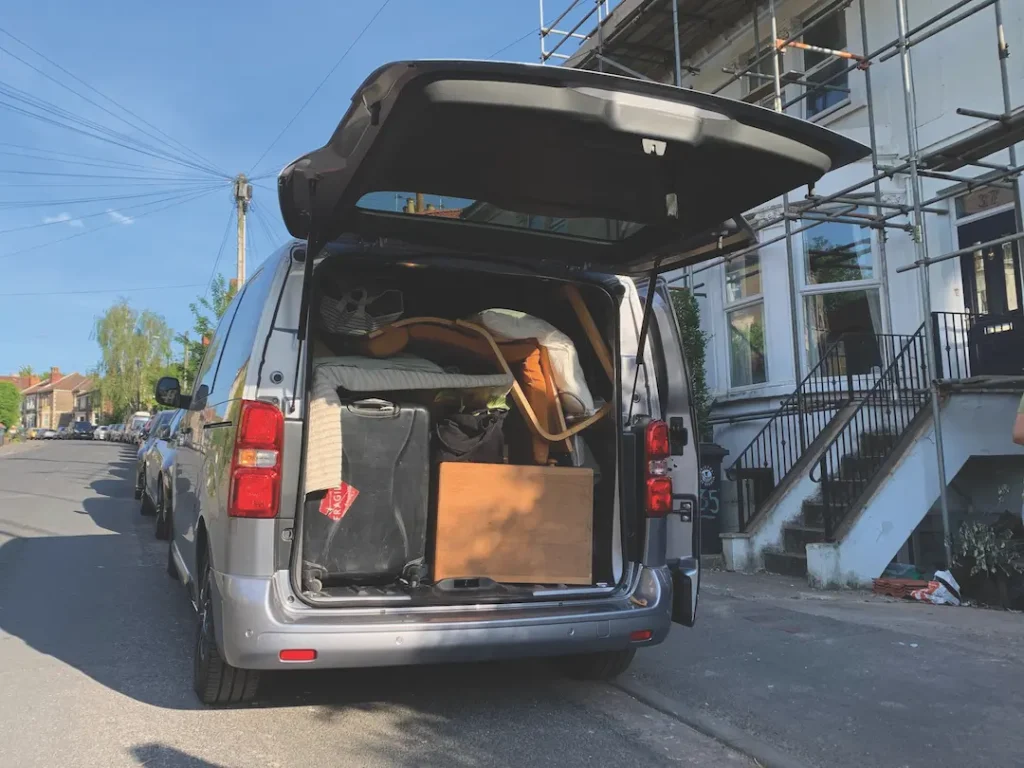
This presented a challenge as one of the first jobs I assigned to the Proace was the end of term task of moving two of my children’s belongings out of their student digs. Whereas the L1 panel van offers a 5.3m3 load bed, rising to 5.8m3 with the load-through hatch, the L1 crew van is restricted to 3.2m3, so judicious use of the available space was called for.
When choosing either a crew or panel van, operators should weigh up whether their priority is carrying a team of workers with a compromised load capacity, sufficient for tools and equipment, for example, or whether they need to maximise load-lugging capability.
With the sliding side doors opening onto the back passenger seats, access to the load area is via the rear tailgate only. A full-height bulkhead divides the double cabin from the load area. It is fitted with a window to give the driver a rear view, but the sight line is largely obscured in practice by the passenger seat headrests. The load bed is equipped with four tie-down loops to help with securing cargo.
Discreet storage compartments for the likes of mobile phones or tablets can be found underneath the three rear seats. A step helps the driver clamber into the front of the cab but the grab handle is not easily located from outside so one tends to grab the steering wheel instead. Once inside, the driver’s seat is supportive and adjustable horizontally and vertically, but I would welcome some lumbar support. The steering wheel is adjustable for height and reach too so finding the best driving position is easy. Frontal arc visibility is decent enough but the side mirrors could really do with a wide-angle section. There is just about room enough for the middle seat passenger, but cross cab access is impeded by the centre console protruding out close to the seats.
In-cab storage is not the best, there is a push-button start but nowhere obvious to put the key fob. Cup holders sit at either end of the dashboard, there’s a glove box, which is not lockable, and an open shelf on top of the dash. The door bins are big and include a section for holding a bottle of water.
Report card
Versatility: The Sport Crew Cab impresses as a carrier of both goods and passengers.
8/10
Cabin: Comfortable, but storage provision could be better.
6/10
| Model | Toyota Proace Sport Crew Cab 2.0 Auto |
| Mileage | 578 |
| Official combined fuel economy | 39.2mpg |
| Our average consumption | 40.3mpg |
| Price range (ex VAT) | £28,474 – £37,765 |
| Price (ex VAT) | £37,765 |
| Insurance group | 35E |
| Warranty | 3yrs/60,000mls (extendable up to 10 years/100,000mls) |
| Service intervals | 10,000mls |
| Load length | 1,488mm |
| Load width (min/max) | 1,258mm /1,636mm |
| Load bay height | 1,397mm |
| Gross payload | 1,226kg |
| Load volume | 3.2m3 |
| Engine size/power | 1,997cc/177hp |
| CO2 | 205g/km |

